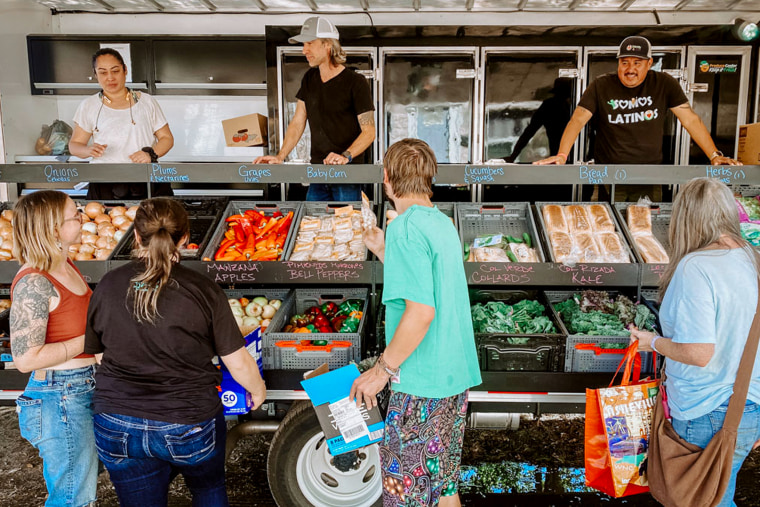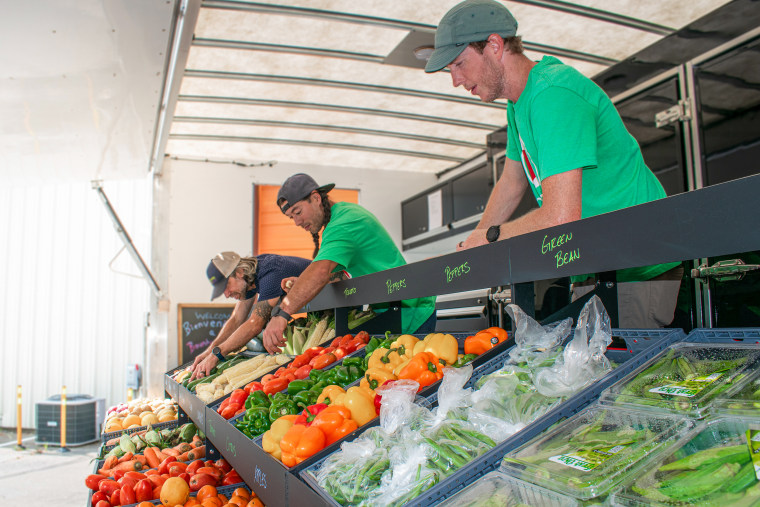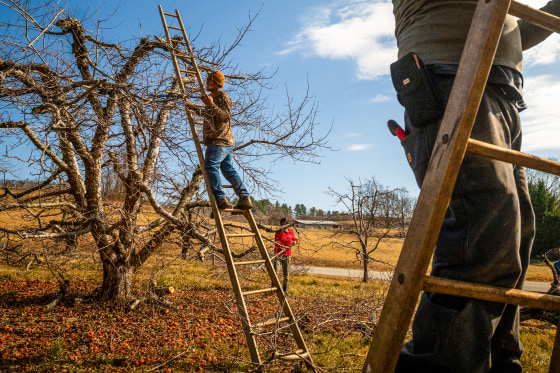Farms in western North Carolina have been scraping by with help from nonprofit groups more than six months after Hurricane Helene’s floodwaters receded.
Much of the region’s agriculture is nestled in valleys where streams and rivers run between mountain peaks. That proximity to water proved devastating for local farmers — who produce everything from fruits and vegetables to pasture-raised beef and even Christmas trees — when the powerful storm swept through in late September. Many still haven’t fully restored operations, said state Rep. Eric Ager, a Democrat who represents a district that includes parts of Buncombe County south of Asheville, including hard-hit Swannanoa.
“I think we’re going to see a real economic downturn from this, which is inevitable, and we need more support,” he said.
State lawmakers passed a $500 aid package last month that includes about $200 million for agricultural crop losses and repairs. The U.S. Agriculture Department told NBC News in March that it had dispersed nearly $30 million for certain needs like debris removal, fence repair and specialty crops.
Democratic Gov. Josh Stein has pushed for more. He sent a letter in February asking the Trump administration and Congress for $19 billion in additional federal aid, estimating that the state suffered nearly $60 billion in damages, including $4.9 billion in its agriculture sector.
Stein said in his letter that existing insurance programs covered only 5% to 10% of crop losses, with private insurers covering about $121 million in agricultural damage as of February and the state chipping in another $27 million.

The White House didn’t comment on Stein’s request but said the administration would continue to support farmers.
“President Trump cares deeply about our farmers and all Americans impacted by the devastation of Hurricane Helene, which is why he personally evaluated the damage and led a historic recovery effort,” spokesperson Anna Kelly said. “He will continue to ensure our farmers have the policies and resources they need to feed the world.”
Local aid organizations say they’re still responding to elevated food insecurity throughout the region.
“The flow of aid from the government — both state and federal government — has not yet scaled to the situation at hand,” said Paula Sellars, deputy director of the local nonprofit group Bounty & Soul.
We’re seven months out, and the large dollars have not yet trickled down to the local person.
Paula Sellars, deputy director of Bounty & Soul
The organization partners with over 70 regional farms to provide free food to communities around Black Mountain and Swannanoa, but Sellars said it has been a heavy lift to expand operations while local growers that supply the group are still getting back on their feet.
Fortunately, Bounty & Soul has seen an outpouring of generosity from people looking to help, and “the scale of what we’re doing has increased tremendously,” she said.
Sellars estimated the group’s food purchasing budget has swelled by 340% since Helene. Before the hurricane, Bounty & Soul would typically organize six food markets a week for those in need; now it runs 10, serving over 25,000 people every month.
While the organization still buys produce from local farmers, it has had to supplement that with purchases from wholesalers to handle higher demand. And Sellars said she knows Bounty & Soul can’t meet the needs of western North Carolinians solely through private donations, which are liable to wane as time goes on.
“The nonprofit sector is very much shouldering the burden of recovery in many of this region’s smaller communities,” she said.
Disasters tend to push out farmers who were already struggling financially, said Michael Swanson, chief agricultural economist at the Wells Fargo Agri-Food Institute, an industry news service.
“Somebody usually takes up the acreage and does the crops, but there’s a shifting around between the people that were doing better and just want to keep on trying it and those that say, ‘I was thinking about getting out anyway,’” Swanson said.

Ager said he has been pushing fellow lawmakers to expedite more funding but warned that the state aid package “is probably getting here a little bit too late to get some fields back up and running in time” for spring planting. State-level relief can be quicker to arrive than federal funding, which is usually administered through the Agriculture Department through local farm service agencies, he said.
“We’re already slow in reality and should have done more sooner,” said Ager, also a fourth-generation farmer who raises beef and pork with his brother at Hickory Nut Gap Farms in Fairview. Helene knocked out power for a month at the property, downed trees and washed out roads.
“There was plenty of cleanup to do,” Ager said, but he added that he “felt pretty fortunate” relative to what other growers endured.
WNC Communities, a local agriculture nonprofit group, has been providing emergency disaster funding for farmers in recent months.
“We filled a gap where we knew that there wasn’t going to be any other funding,” said Executive Director Jennifer Ferre, who estimated having doled out $2.1 million to 385 farmers so far.
Like other local nonprofit groups, WNC Communities received an influx of private donations that it distributed quickly to help farmers restart operations as best they could. But there were limits to the organization’s support — it could often help buy gravel to repair a road between pastures but not rebuild a collapsed barn, Ferre said.
“The need was so overwhelming,” she said. “We had to look and try to prioritize what we thought was going to be able to help folks ... get back into business the quickest.”
Ferre said she’s also trying to be a resource for the farmers her group has assisted as new funding turns up. Applying for grants can be complicated, and it requires documentation of losses at a time when many farmers are simply trying to pay their bills.
What farmers need is “quick money,” said Laura Lauffer, director of the EmPOWERing Mountain Food Systems program at North Carolina State University. By the time Helene hit, her initiative had already set up a program offering $3,000 business grants for regional farmers. Afterward, it streamlined the application process to get money out faster.
“We want to be really strategic,” Lauffer said, adding that the group is focused now on figuring out “how we can have the most impact with this little bit of money.”
The start of this year has brought substantial cuts at the Agriculture Department, including $1 billion in food bank and school lunch programs, as part of a sweeping Trump administration push to downsize government that has frequently generated chaos, confusion and policy reversals.
The Agriculture Department “is working diligently to roll out our portion of the disaster assistance across the U.S. over the coming months,” a White House spokesperson said in a statement. A spokesperson for the agency said Agriculture Secretary Brooke Rollins is focused on addressing the needs of impacted farmers and “will ensure that those areas have the resources and personnel they need to continue serving the American people.”
For now, the need gap remains.
“To legislators and those who are in positions of decision-making around disaster relief funding, I would just say: Please pick up the pace,” Sellars said. “We’re seven months out, and the large dollars have not yet trickled down to the local person.”
